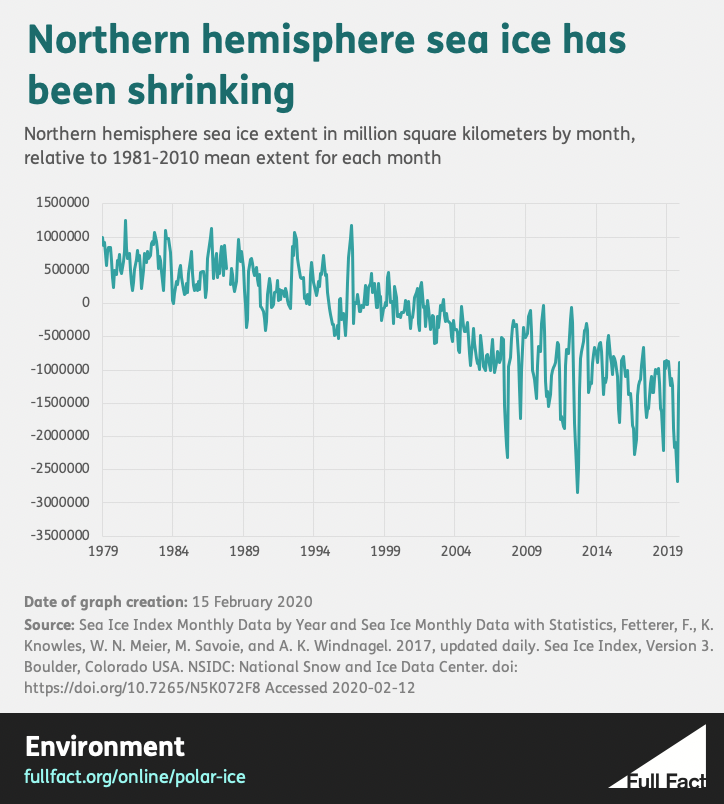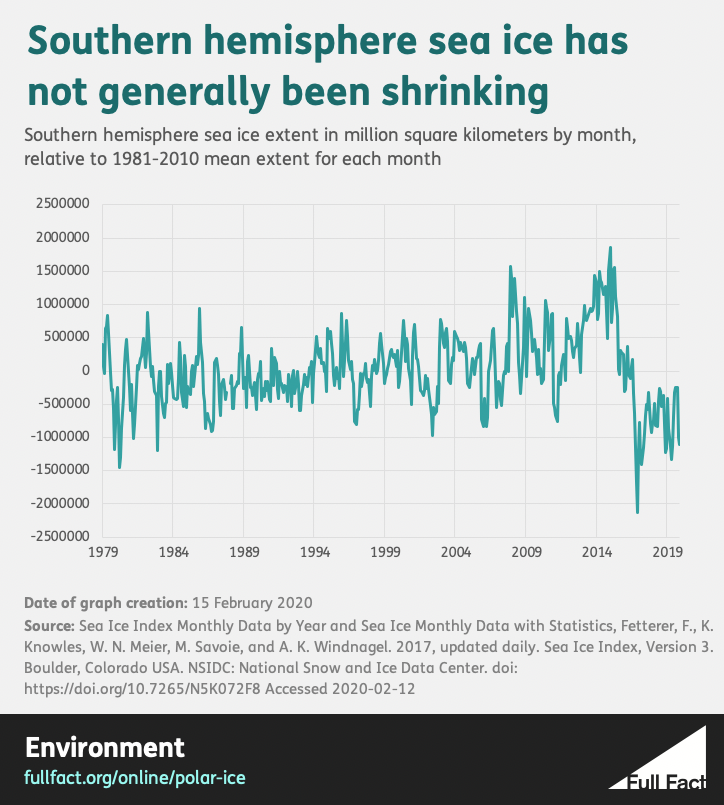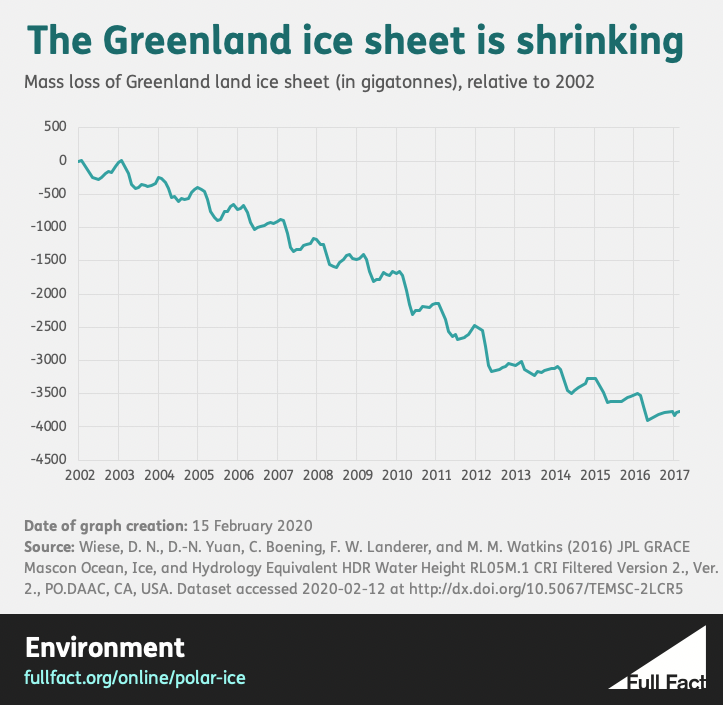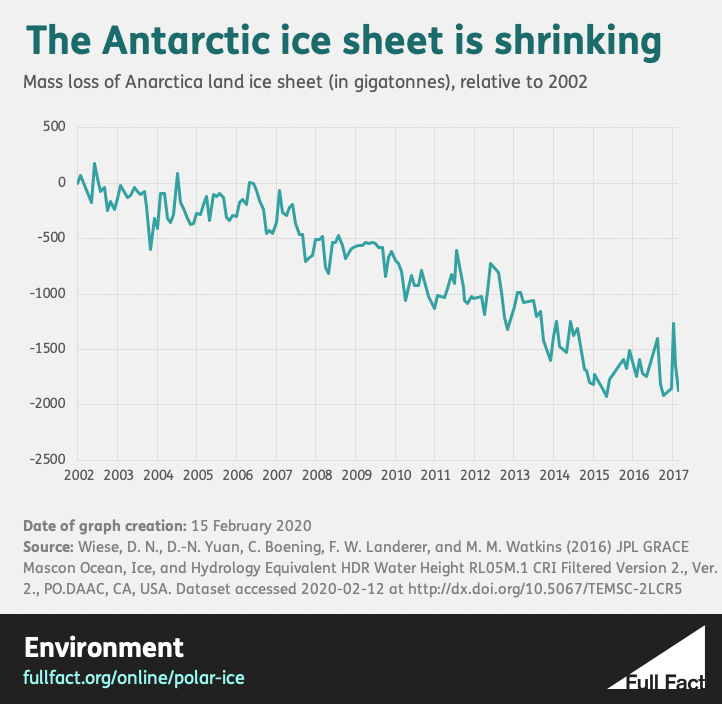A post on Facebook contrasts an alleged quote by environmental campaigner and former US Vice President Al Gore (“I predict the ice caps will melt by 2014”) with the claim that a 2015 NASA report said there was “more ice than ever”.
Both of the claims are wrong. Al Gore did not predict that, and there was not more ice than ever in 2015. The claims are not entirely baseless (Mr Gore did make more limited inaccurate predictions), but they misinterpret or misrepresent both Mr Gore’s words and what’s happened to the ice caps.
Overall, the amount of polar ice has been declining for decades.
Honesty in public debate matters
You can help us take action – and get our regular free email
What did Al Gore say?
Al Gore did not say that “the ice caps will melt by 2014”. However (as summarised well by the fact checking website Snopes) he did promote more limited predictions during the late 2000s which did not come true. Specifically, he talked (in imprecise language) about projections that the summer sea ice in the Arctic could have disappeared by that year .
To understand why that’s not the same as a blanket claim that “the ice caps will melt”, it’s important to remember that there are two polar regions—the Arctic in the north, and the Antarctic in the south.
Beyond that, there are different types of ice: these include ice sheets, the thick layers of ice covering land masses; ice shelves, which are parts of the ice sheet that extend from the land over the ocean; and sea ice, which is a thinner, free-floating layer of ice made of frozen ocean water.
And finally, the amount of ice naturally increases and decreases according to the season, with more ice in the cold winter months and less ice in the summer.
Mr Gore’s comments referred to a real projection, made at a meeting of the American Geophysical Union, that was specifically about one type of ice—sea ice—at the North Pole only, in the warmest months of the year. But he didn’t always make clear that this projection was something of an outlier, which suggested faster melting than other scientific models.
He also used the phrase “North Polar ice cap” when talking about the sea ice projection—and while the ice at the North Pole itself is sea ice, there is also an ice sheet covering Greenland, so the phrase could be interpreted as covering a wider area than the projection actually did.
As Snopes concludes: “The claim that Gore ‘predicted’ an ice-free Arctic in 2014 is a simplification of these events. However, Gore was definitely guilty in these cases of cherry-picking science or playing loose with the details of that science.”
What actually happened to the ice?
The second part of the Facebook post similarly makes a mistake by saying that there was “more ice than ever” in 2015.
While wrong, there is a grain of truth here. Antarctic sea ice, specifically, was on a slight upward trend until recently, and did reach its highest level around this time.
The largest extent of Antarctic sea ice since 1979 (when the modern satellite records begin) was recorded in September 2014, in the Antarctic winter. And on a month-by-month basis, January 2015 outstripped its monthly average by the largest amount (although there was less ice overall, as January is in the Antarctic summer.)
But other ice types were shrinking at the same time. (Additionally, what’s happening to sea ice is far less important when it comes to sea levels rising than what’s happening to the ice sheets).
In the Arctic, the extent of sea ice has been declining for decades. There wasn’t “more ice than ever” on the Arctic Ocean in 2015, either in the summer or the winter—every month in 2015 had a sea ice extent far below the monthly averages for the years 1981-2010.
As already noted, unlike Arctic sea ice, the extent of Antarctic sea ice has not generally been declining in recent decades. In fact, up to mid-2015, it had been rising slightly. That trend changed dramatically in 2016 and 2017, when it fell to its lowest ever point.
The reasons why Antarctic sea ice behaves differently to the Arctic are complex and still not fully understood, but relate to the fact that the two poles are… well, polar opposites: the Arctic is an ocean surrounded by land masses, while the Antarctic is a land mass surrounded by ocean.
And that means that if you just look at the sea ice around Antarctica, you may get a misleading picture of what’s going on.
Sea ice isn’t the only ice, and it’s not the most important
Receding sea ice in the Arctic may be a visible effect of climate change, and have significant effects on the ecosystem, but as we’ve already noted it has relatively little direct effect on sea level rise: the ice layer is comparatively thin, and (because it’s already floating in the sea) it doesn’t raise the water level very much when it melts.
What contributes most to sea level rise is the melting of the much thicker ice sheets on land. And here the story from north and south is similar: both the Antarctic ice sheet and the ice sheet covering Greenland have been shrinking for the past two decades, with Greenland currently melting faster.
In 2015, around the same time Antarctic sea ice was at its largest extent, the Antarctic ice sheet actually hit its lowest point on record. That’s not as contradictory as it might sound, because the cold, fresh meltwater flowing off the ice sheet can actually increase the amount of surrounding sea ice. That’s one reason why just looking at sea ice could give you a misleading impression of what’s happening to Antarctica’s ice overall.



